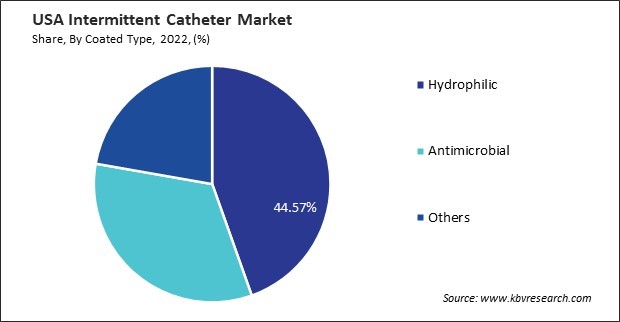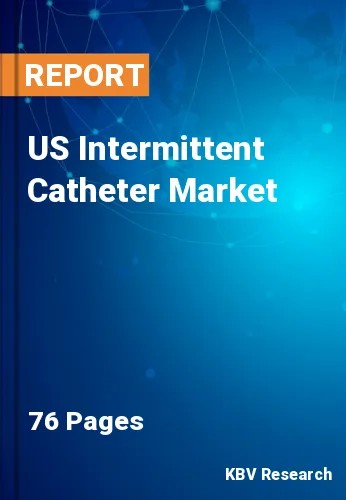The USA Intermittent Catheter Market size is expected to reach $664.9 million by 2030, rising at a market growth of 3.2% CAGR during the forecast period. In the year 2022, the market attained a volume of 1,70,849.8 thousand units, experiencing a growth of 3.4% (2019-2022).
The intermittent catheter market in the United States has witnessed significant growth and transformation in recent years, driven by demographic trends, technological advancements, and changes in healthcare practices. Healthcare policies, including reimbursement structures, influence the intermittent catheter market. Changes in reimbursement policies impact the accessibility of these devices for patients, influencing industry dynamics. Manufacturers and healthcare providers closely monitor regulatory developments to align their strategies with evolving healthcare frameworks.

The intermittent catheter market in the United States plays a crucial role in addressing the healthcare needs of individuals with conditions such as spinal cord injuries, urinary retention, and neurogenic bladder dysfunction. Intermittent catheters are medical devices designed to assist in urinating urine from the bladder when a person cannot do so naturally. The catheter industry has witnessed significant growth, driven by factors such as an aging population, an increasing incidence of spinal cord injuries, and advancements in catheter technology.
The exponential growth in U.S. healthcare spending, which reached $4.5 trillion in 2022, indicates the considerable financial resources allocated to addressing the population's healthcare needs. Amidst this vast healthcare landscape, the intermittent catheter market is one crucial segment witnessing significant traction. Health spending reached $13,493 per person, highlighting the substantial financial burden associated with healthcare, making cost-effective and efficient solutions, such as intermittent catheters, even more critical.
The healthcare industry in the United States is experiencing a surging demand for intermittent catheters, reflecting a growing awareness of urological conditions and an aging population with associated healthcare needs. Intermittent catheters play a crucial role in managing various urological disorders, such as urinary retention and incontinence, providing a convenient and effective solution for patients. The healthcare landscape in the U.S. has seen improvements in reimbursement policies for intermittent catheter market, making these devices more financially accessible for patients. As awareness campaigns and educational initiatives on urological health gain momentum, more individuals are likely to seek medical intervention, further propelling the demand for intermittent catheters.
In the United States, surge in demand for intermittent catheters in the healthcare industry is also influenced by shifting healthcare preferences towards minimally invasive and patient-centric approaches. Intermittent catheterization offers a less invasive option compared to indwelling catheters, reducing the risk of complications such as urinary tract infections. This has led to a preference for intermittent catheters, particularly among healthcare providers aiming to optimize patient outcomes and satisfaction. The evolving regulatory landscape and standards for urological care have also influenced the intermittent catheter market in U.S. Stricter guidelines and quality assurance measures have bolstered consumer confidence in these medical devices, encouraging higher adoption rates. Regulatory initiatives aimed at ensuring the safety and efficacy of intermittent catheters have played a crucial role in fostering a positive perception among healthcare professionals and patients alike.
The escalating healthcare spending, accounting for 17.3 percent of the nation's gross domestic product (GDP), underscores the economic significance of healthcare in the U.S. Within this context, the intermittent catheter market plays a pivotal role in managing urological disorders, a prevalent health concern contributing to this growing expenditure. Individuals with urological disorder conditions often require consistent and reliable solutions, like intermittent catheters, which aid in reducing the overall healthcare burden by preventing complications such as urinary tract infections and hospitalizations.
Hydrophilic coatings play a pivotal role in the intermittent catheter market in the United States, contributing to improved patient comfort, ease of use, and a reduced risk of complications. These coatings are designed to enhance the lubricity of catheters, allowing for smoother insertion and withdrawal during catheterization. As a result, patients experience less friction and discomfort, promoting a more positive user experience.
In the U.S. intermittent catheter market, hydrophilic coatings offer a primary advantage by significantly reducing the risk of urinary tract infections (UTIs) and related complications associated with catheter use. The hydrophilic coating creates a smooth and slippery surface, minimizing the chances of bacteria adhering to the catheter. This is particularly crucial for individuals undergoing long-term catheterization, as they face a higher susceptibility to UTIs. Integrating hydrophilic coatings aligns with the broader healthcare objective in the United States of reducing hospital readmissions and enhancing overall patient outcomes.
Another notable impact of hydrophilic coatings in the U.S. industry is their influence on patient compliance. The improved ease of catheter use, facilitated by these coatings, fosters greater patient adherence to catheterization schedules. This, in turn, promotes enhanced self-management of healthcare, a critical aspect of the U.S. healthcare system. Therefore, by addressing issues related to patient comfort, reducing infection risks, and promoting adherence to catheterization regimens, these coatings contribute to a more patient-centric and effective approach to catheter use.

The U.S. intermittent catheter market is characterized by several key companies that play a vital role in meeting the diverse needs of patients requiring catheterization. One prominent player in this industry is Coloplast, a global healthcare company specializing in intimate healthcare products. Coloplast offers a range of intermittent catheters designed for comfort and ease of use, incorporating features such as hydrophilic coatings and innovative designs. The company's commitment to advancing patient care is reflected in its continuous efforts to introduce cutting-edge technologies and improve the overall user experience for individuals in the U.S. who rely on intermittent catheters.
Another significant participant in the U.S. intermittent catheter market is Hollister Incorporated, a company recognized for its focus on creating medical products that enhance the quality of life for individuals with healthcare needs. Hollister's intermittent catheters are designed to provide discretion, simplicity, and optimal comfort. The company emphasizes user-friendly designs and has a comprehensive product line catering to patient preferences and requirements. Hollister's presence in the U.S. industry underscores its commitment to addressing the unique challenges of patients who depend on intermittent catheters for their daily healthcare routines.
Additionally, Boston Scientific is a notable player contributing to the U.S. intermittent catheter market. With a global presence, Boston Scientific is dedicated to providing innovative medical solutions, including intermittent catheters, to improve patient outcomes. The company's focus on research and development ensures that its catheter products incorporate the latest advancements in technology, offering patients in the U.S. a variety of options to meet their specific demands. Boston Scientific's commitment to quality and innovation reinforces its position as a key player in the dynamic landscape of the U.S. intermittent catheter market.
By Product
By Indication
By End User
By Category
Our team of dedicated experts can provide you with attractive expansion opportunities for your business.

